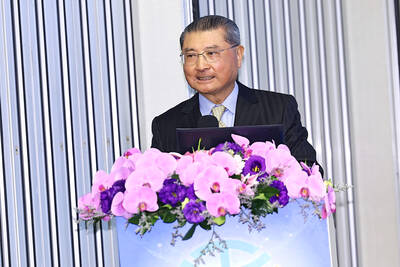Hon Hai Precision Industry Co (鴻海精密), which assembles Apple Inc’s iPads and iPhones as well as electronic gadgets for other brands, yesterday said its revenue contracted about 11 percent sequentially to NT$1.3 trillion (US$41.7 billion) last quarter, attributing it to faltering demand for smart consumer electronics, smartphones primarily.
The demand for two categories — computer products and cloud and networking products — was higher than expected, which was boosted by new PC product launches by customers, the company said.
Revenue from the two categories registered a quarterly growth last quarter, exceeding Hon Hai’s previous expectation of a flat performance, the company said.

Photo: Fang Wei-chieh, Taipei Times
Hon Hai expected PC customers’ inventory digestion efforts to approach an end in the second quarter, while server customers from enterprises might take until the third quarter, Hon Hai chairman Young Liu (劉揚偉) told investors in May.
Revenue from electronic components such as camera lenses showed robust growth quarter-on-quarter as the company expected, Hon Hai said.
Market share gains also helped drive the growth, the company said.
On an annual basis, revenue sank 13.75 percent last quarter compared with NT$1.51 trillion in last year’s second quarter. During the first six months of this year, revenue dropped 5.25 percent year-over-year to NT$2.77 trillion compared with NT$2.92 trillion during the corresponding period last year.
Businesses would gradually ramp up this quarter as the electronics industry’s peak season is under way, Hon Hai said.
Revenue this quarter is expected to pick up at a slightly faster pace, compared with the quarterly growth rate of 16 percent registered in the third quarter last year and 4 percent in the third quarter in 2021, Hon Hai said.
The revenue growth rate is expected to be approximately on par with the pre-pandemic period, Hon Hai said.
For the full year this year, revenue would be little changed from last year’s NT$6.63 trillion, Liu said in May.
The conservative estimate came as growing macroeconomic uncertainty blurred order visibility, Liu said at the time.
This year as a whole, PC products and optoelectronic components would be the major growing areas, he said.
However, it would be a big challenge to retain its gross margin at a similar level with last year at 6.04 percent, given volatility in foreign exchange rates and extra operating spending due to pandemic measures, Liu said.
The company maintained its 10 percent gross margin target for 2025, Liu said.
Hon Hai is to release detailed financial figures and provide updates about its business outlook in an investors’ conference on Aug. 14.

When an apartment comes up for rent in Germany’s big cities, hundreds of prospective tenants often queue down the street to view it, but the acute shortage of affordable housing is getting scant attention ahead of today’s snap general election. “Housing is one of the main problems for people, but nobody talks about it, nobody takes it seriously,” said Andreas Ibel, president of Build Europe, an association representing housing developers. Migration and the sluggish economy top the list of voters’ concerns, but analysts say housing policy fails to break through as returns on investment take time to register, making the

‘SILVER LINING’: Although the news caused TSMC to fall on the local market, an analyst said that as tariffs are not set to go into effect until April, there is still time for negotiations US President Donald Trump on Tuesday said that he would likely impose tariffs on semiconductor, automobile and pharmaceutical imports of about 25 percent, with an announcement coming as soon as April 2 in a move that would represent a dramatic widening of the US leader’s trade war. “I probably will tell you that on April 2, but it’ll be in the neighborhood of 25 percent,” Trump told reporters at his Mar-a-Lago club when asked about his plan for auto tariffs. Asked about similar levies on pharmaceutical drugs and semiconductors, the president said that “it’ll be 25 percent and higher, and it’ll

CHIP BOOM: Revenue for the semiconductor industry is set to reach US$1 trillion by 2032, opening up opportunities for the chip pacakging and testing company, it said ASE Technology Holding Co (日月光投控), the world’s largest provider of outsourced semiconductor assembly and test (OSAT) services, yesterday launched a new advanced manufacturing facility in Penang, Malaysia, aiming to meet growing demand for emerging technologies such as generative artificial intelligence (AI) applications. The US$300 million facility is a critical step in expanding ASE’s global footprint, offering an alternative for customers from the US, Europe, Japan, South Korea and China to assemble and test chips outside of Taiwan amid efforts to diversify supply chains. The plant, the company’s fifth in Malaysia, is part of a strategic expansion plan that would more than triple

Taiwanese artificial intelligence (AI) server makers are expected to make major investments in Texas in May after US President Donald Trump’s first 100 days in office and amid his rising tariff threats, Taiwan Electrical and Electronic Manufacturers’ Association (TEEMA, 台灣電子電機公會) chairman Richard Lee (李詩欽) said yesterday. The association led a delegation of seven AI server manufacturers to Washington, as well as the US states of California, Texas and New Mexico, to discuss land and tax issues, as Taiwanese firms speed up their production plans in the US with many of them seeing Texas as their top option for investment, Lee said. The